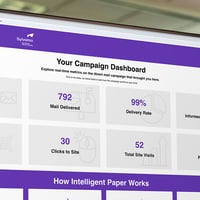Digital Dish: June 2020
Each dish will feature a new nugget to chew on and fuel your digital cravings. This month, Jennifer Pennington from Eastman Kodak returns as host. As a seasoned veteran in Kodak's inkjet business for over 15 years, she helps educate customers and partners on the importance of paper for inkjet printing. Keep reading to learn more from Jen about Kodak's efforts to simplify its ink set, expand paper compatibility and collaborate with paper mills to ensure customers using the PROSPER series presses receive a return on their investment.
SIMPLIFY INK SELECTION
When investing in production inkjet technology, selecting the right ink - think dye, pigment, etc. - requires evaluating ink costs, drying requirements and capabilities, effects on print head life, achievable color gamut, image permanence, and environmental considerations against the intended print applications. Kodak uses one basic ink technology, a low-humectant, nanoparticle, water-based pigment ink to print on a wide range of substrates, including uncoated papers and paperboard as well as coated papers and paperboard. By having one ink technology, Kodak is able to more readily advance its continuous inkjet (CIJ) printhead technology from Stream to ULTRASTREAM and beyond without having to worry about backward compatibility of the hardware with multiple ink technologies.
EXPAND PAPER COMPATIBILITY
As the volume of jobs printed digitally grows, Kodak, like many other OEMs, is driven by its mission to expand paper compatibility on its PROSPER presses using:
- Self-monitoring, automated color adjustments based on metrics tracked throughout the run
- Fast, intelligent drying, giving customers' work the look and feel of offset without the cockle and curl seen in inkjet printing
- A choice of multiple web paths (depending on ink coverage and drying needs) that minimizes press downtime by reducing potential substrate issues
- Stream Inkjet Technology, which allows greater distance between jetting modules and the substrate, eliminating much of the potential for damage to the web or modules themselves
- Patented anti-wrinkle rollers and a turn bar that enables heavy ink coverage on lightweight papers and more paper types to be printed at full speed with less scuffing or scratching.
- Image Optimizer Station that offers in-line treatment on untreated papers
COLLABORATE WITH MILLS
For more than five decades, Kodak has collaborated with 40 paper mills around the world to test more than 5,000 paper samples as well as develop more than 100 new papers specifically formulated for CIJ printing. To inform and simplify the paper purchasing decisions, Kodak developed its robust certification program, the PROSPER Paper Rating System (PPRS). Using standard test conditions, Kodak evaluates substrates on five key metrics and then ranks them from one to five diamonds:
- Optical density (OD)
- Show-through
- Line raggedness
- Color-to-color bleed
- Ink mottle/uniformity
The PPRS provides image quality ratings for more than 80 substrates. Two-thirds of the rated papers are treated/enhanced and designed for inkjet inks, while the other one-third is standard offset paper grades ideal for monochrome text applications. Data from testing shows that treated inkjet papers have specific advantages for image quality. The PPRS enables customers to compare similar papers and grades and make informed, application-specific decisions based on quality and economics.
HAPPY FOURTH OF JULY
Thank you again to Jen and Kodak for contributing to this month's Digital Dish. Stay tuned for more information from Kodak throughout the year. For a complete list of Sylvamo's digital inkjet product line, visit our website.
And on behalf of Sylvamo, we want to wish you a Happy 4th of July to relax and renew! It's important more than ever to keep the health and safety of you and those around you top of mind, so if you're leaving your home this weekend to celebrate, we encourage you to wear your mask!






